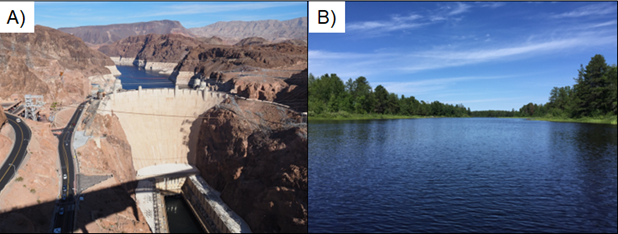Highways and hubs: Helping freshwater wildlife keep up with climate change
MSU researchers examined how freshwater wildlife navigates waterways in the face of climate change and humans altering the landscape.
Like many others, perhaps you took a vacation this summer. If you drove, chances are that you traveled along major highways. If you flew, you likely traveled through a large airport, quite possibly a hub for a major airline. This is because highways and hubs typically comprise the most efficient long-distance routes to popular destinations.
As it turns out, the same is largely true for wildlife. Under a changing climate, wildlife are generally trying to move to cooler locations further north or to higher elevations, known as “range shifts.” Many species also migrate long distances to breed, such as many backyard birds and fishes such as salmon.
One of the greatest challenges for wildlife, however, is actually getting to their destinations given how heavily humans have modified landscapes and waterways. Perhaps ironically, the infrastructure that humans use to get around such as roads, railways and airports, as well as cities, fences and other human-made structures, effectively create obstacles for wildlife.

One type of obstacle that can be particularly challenging for wildlife to clear are the tens of thousands of dams across the lower 48 U.S. states. Although dams help control water supplies and generate electricity, dams make it difficult for fishes and other freshwater wildlife to swim to other areas, which may be important for spawning or escaping to cooler locations in response to climate change.
Prior to the construction of dams, the U.S. was home to hundreds of vast networks of connected streams, rivers and lakes. Structurally, freshwater networks are like networks of highways or flights. They often contain numerous branches that diverge in various directions from centralized hubs. Without these hubs, networks can easily fall apart.
“What would happen if Delta Airlines, for example, suddenly lost the Detroit Metro Airport? Their route network would collapse,” said lead author Ian McCullough, a research scientist at Michigan State University. “We’re seeing a similar thing in freshwater networks. Dams can really disrupt natural connectivity among different rivers, streams and lakes if we put them in the wrong place.”
In a paper recently published in the journal Ecosphere, McCullough and a team of researchers evaluated the current capacity of freshwater networks in the lower 48 states to act as natural highways for freshwater wildlife. They assigned each network a “connectivity score” based on a combination of network size, north-south distance spanned, prevalence of dams and susceptibility to network fragmentation.
Perhaps not surprisingly, 68% of 385 assessed networks received low connectivity scores. In contrast, just 3% of networks received high connectivity scores, indicating that only a few networks are capable of facilitating long-distance migrations and species range shifts under climate change.
Overall, the study found that most networks are small, spanning a median of 5-6 km north to south and containing a median of 3 lakes. On the other hand, larger networks are relatively rare: just 10% of networks contain at least 50 lakes and just 8% span greater than 100 km north to south.
“The few networks that are large enough to support long-distance migrations and range shifts tend to be the most heavily dammed,” said co-author Katelyn King, a Ph.D. graduate from MSU and now postdoctoral researcher at University of Michigan.
For example, the largest, highest-scoring network in the Midwest is the Red River network, found in Minnesota, North Dakota and parts of Canada. In the U.S., this network contains 754 lakes and spans 380 km north to south, but also has 250 dams. Among all networks, the Colorado River network received the highest network connectivity score. Although this network spans 1,330 km north to south and contains 2,027 lakes, it also has 954 dams. The Mississippi River network is so large (nearly 33,000 lakes and 25,000 dams) that it was considered its own category.
Given that removing dams or rerouting waterways across the country is impractical, the study also looked for freshwater network hubs, essentially lakes that act as centralized points within larger networks. In total, the study identified 2,080 hub lakes across the lower 48 states, including 131 in Michigan. Although these hub lakes represent just 2% of all network lakes in the lower 48, they are disproportionately important for maintaining intact freshwater networks and therefore facilitating wildlife movements. Therefore, maintaining hubs within freshwater networks could be really helpful for wildlife conservation.
The study found, however, that hub lakes were no more likely to be found in protected areas than any given lake. This also may be unsurprising given that most protected areas (e.g., national parks) in the US are designed for species and habitats on land. Nonetheless, focusing on increasing natural connectivity at these hub lakes, such as with fish ladders or modifying or removing dams, could represent an efficient strategy for restoring freshwater networks and wildlife populations, particularly given limited resources for restoration and conservation.
An important next step is monitoring wildlife at hub lakes to study to what extent they act as natural hubs within larger freshwater networks.
“There really are only so many possible routes for wildlife to take, particularly when seeking to travel long distances,” McCullough added. “Therefore, it would be surprising if species, including invasive species, did not use network hubs. Where else would they go?”
The open-access article can be freely downloaded here: https://doi.org/10.1002/ecs2.4326.



 Print
Print Email
Email




